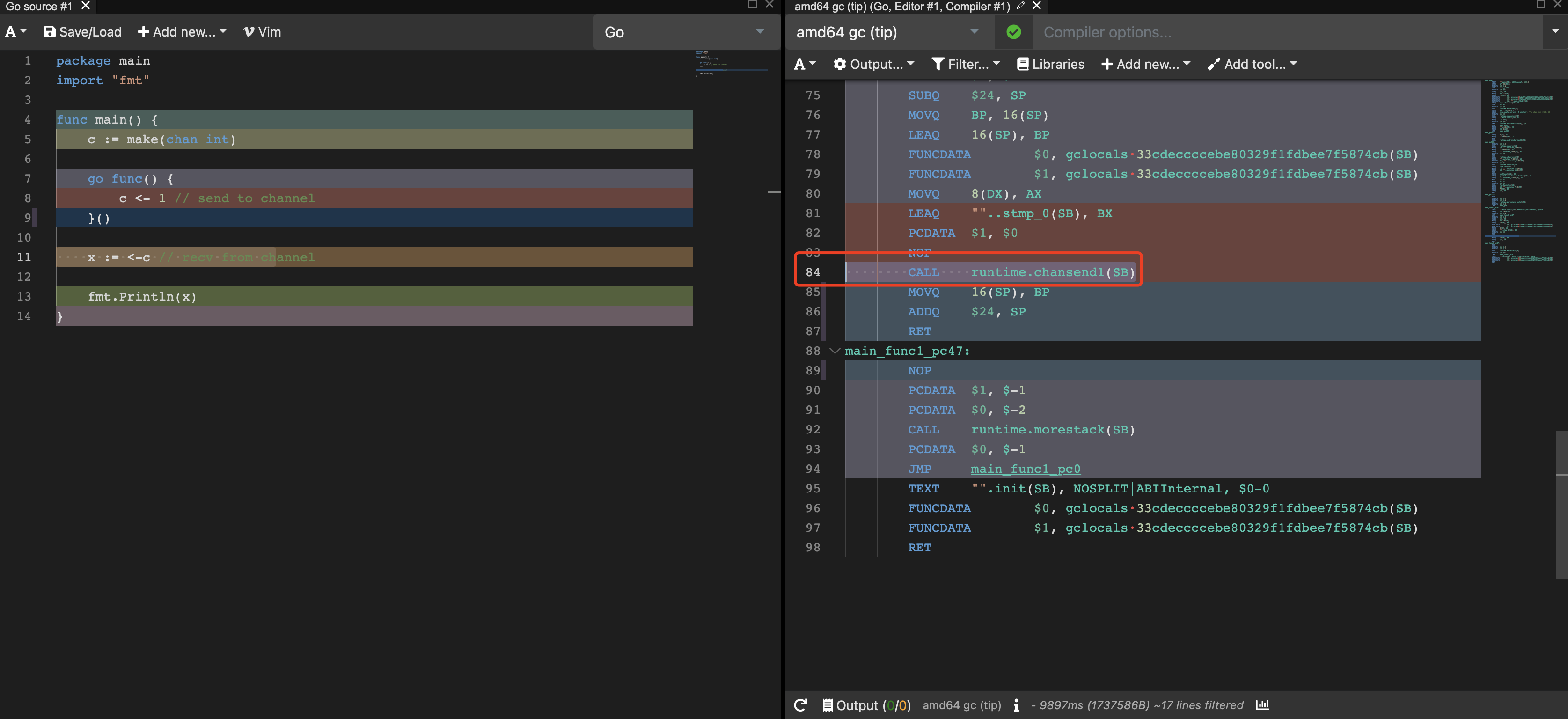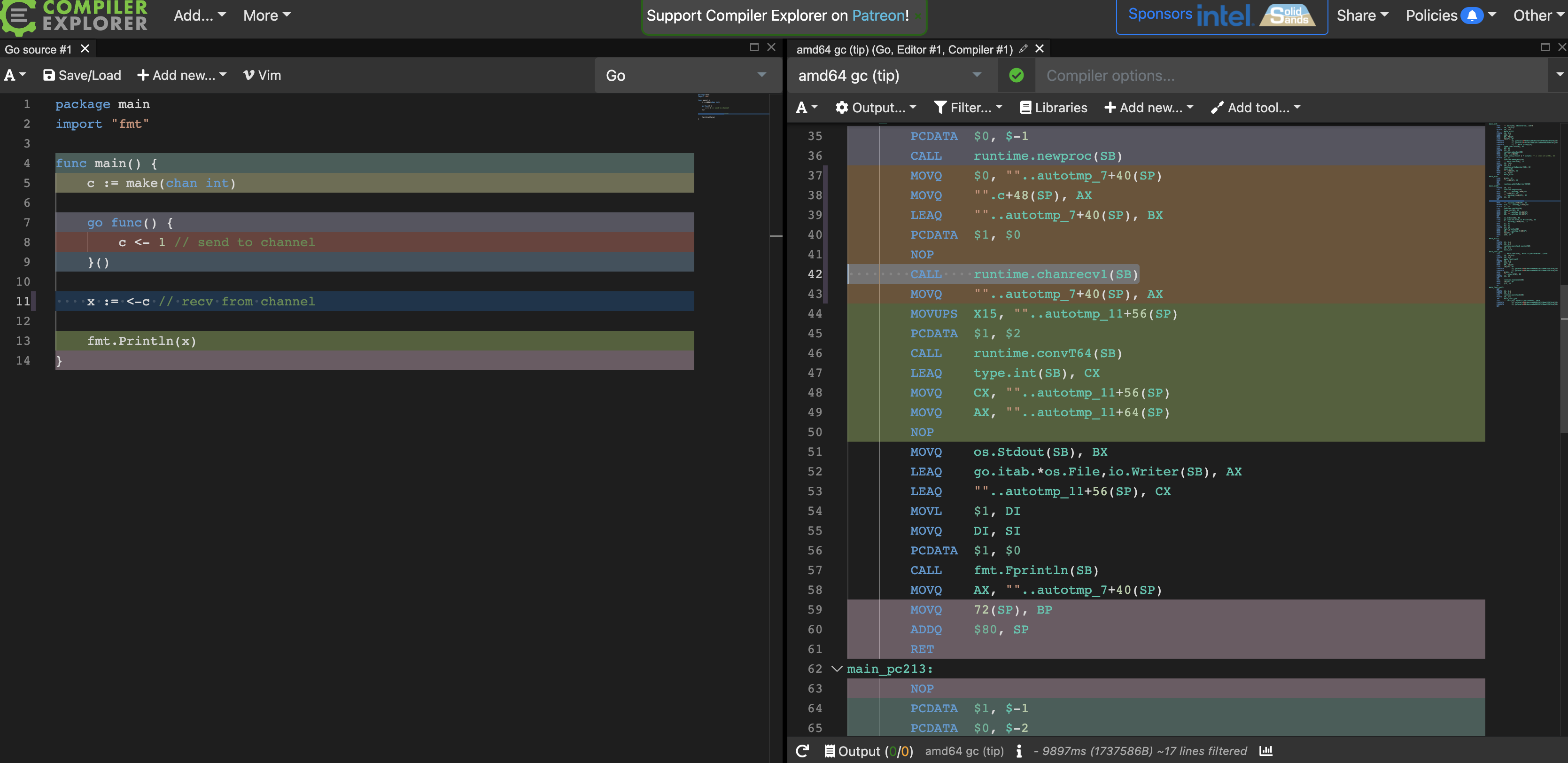前言
channel 是 Golang 中一个非常重要的特性,也是 Golang CSP 并发模型的一个重要体现。简单来说就是,goroutine 之间可以通过 channel 进行通信。
channel 在 Golang 如此重要,在代码中使用频率非常高,以至于不得不好奇其内部实现。本文将基于 go 1.17 的源码,分析 channel 的内部实现原理。
channel 的基本使用
在正式分析 channel 的实现之前,我们先看下 channel 的最基本用法,代码如下:
1 | package main |
在以上代码中,我们通过 make(chan int) 来创建了一个类型为 int 的 channel。
在一个 goroutine 中使用 c <- 1 将数据发送到 channel 中。在主 goroutine 中通过 x := <- c 从 channel 中读取数据并赋值给 x。
以上代码对应了 channel 的两种基本操作:
- send 操作
c <- 1表示发送数据到 channel - recv 操作
x := <- c表示从 channel 中接收数据。
此外,channel 还分为有缓存 channel 和无缓存 channel。上述代码中,我们使用的是无缓冲的 channel。对于无缓冲的 channel,如果当前没有其他 goroutine 正在接收 channel 数据,则发送方会阻塞在发送语句处。
我们可以在 channel 初始化时指定缓冲区大小。例如,make(chan int, 2) 则指定缓冲区大小为 2。在缓冲区未满之前,发送方无阻塞地可以往 channel 发送数据,无需等待接收方准备好。而如果缓冲区已满,则发送方依然会阻塞。
channel 对应的底层实现函数
在探究 channel 源码之前,我们肯定首先需要先找到 channel 在 Golang 的具体实现在哪。因为我们在使用 channel 时,用的是 <- 符号,并不能直接在 go 源码中找到其实现。但是 Golang 编译器必然会将 <- 符号翻译成底层对应的实现。
我们可以使用 Go 自带的命令: go tool compile -N -l -S hello.go, 将代码翻译成对应的汇编指令。
或者,直接可以使用 Compiler Explorer 这个在线工具。对于上述示例代码可以直接在这个链接看其汇编结果: go.godbolt.org/z/3xw5Cj。如下图:

chansend1

chanrevc1
通过仔细查看以上示例代码对应的汇编指令,可以发现以下的对应关系:
channel 的构造语句 make(chan int), 对应的是 runtime.makechan 函数
发送语句 c <- 1, 对应的是 runtime.chansend1 函数
接收语句 x := <- c, 对应的是 runtime.chanrecv1 函数
以上几个函数的实现都位于 go 源码中的 runtime/chan.go 代码文件中。我们接下来针对这几个函数,探究下 channel 的实现。
channel 的构造
channel 的构造语句 make(chan int),将会被 golang 编译器翻译为 runtime.makechan 函数, 其函数签名如下:
1 | func makechan(t *chantype, size int) *hchan |
其中,t *chantype 即构造 channel 时传入的元素类型。size int 即用户指定的 channel 缓冲区大小,不指定则为 0。该函数的返回值是 *hchan。hchan 则是 channel 在 golang 中的内部实现。其定义如下:
1 | type hchan struct { |
hchan 中的所有属性大致可以分为三类:
- buffer 相关的属性。例如
buf、dataqsiz、qcount等。 当 channel 的缓冲区大小不为 0 时,buffer 中存放了待接收的数据。使用ring buffer实现。 - waitq 相关的属性,可以理解为是一个 FIFO 的标准队列。其中
recvq中是正在等待接收数据的 goroutine,sendq中是等待发送数据的 goroutine。waitq 使用双向链表实现。 - 其他属性,例如 lock、elemtype、closed。
通过简单分析 hchan 的属性,我们可以知道其中有两个重要的组件,buffer 和 waitq。hchan 所有行为和实现都是围绕这两个组件进行的。
向 channel 中发送数据
channel 的发送和接收流程很相似,我们先分析下 channel 的发送过程 (如 c <- 1), 对应于 runtime.chansend 函数的实现。
在尝试向 channel 中发送数据时,如果 recvq 队列不为空,则首先会从 recvq 中头部取出一个等待接收数据的 goroutine 出来。并将数据直接发送给该 goroutine。代码如下:
1 | lock(&c.lock) |
我们看到当我们整个send的过程是需要加锁处理的,并且也可以看到我们老生常谈的一个问题,当向cloesd的channel数据的时候,会导致panic产生
recvq 中是正在等待接收数据的 goroutine。当某个 goroutine 使用 recv 操作 (例如,x := <- c),如果此时 channel 的缓存中没有数据,且没有其他 goroutine 正在等待发送数据 (即 sendq 为空),会将该 goroutine 以及要接收的数据地址打包成 sudog 对象,并放入到 recvq 中。
继续接着讲上面的代码,如果此时 recvq 不为空,则调用 send 函数将数据拷贝到对应的 goroutine 的堆栈上。
这个时候不经过我们的环形缓存!!!
send 函数的实现主要包含两点:
memmove(dst, src, t.size)进行数据的转移,本质上就是一个内存拷贝。goready(gp, skip+1)goready 的作用是唤醒对应的 goroutine。
而如果 recvq 队列为空,则说明此时没有等待接收数据的 goroutine,那么此时 channel 会尝试把数据放到缓存中。
1 | if c.qcount < c.dataqsiz { |
以上代码的作用其实非常简单,就是把数据放到 buffer 中而已。此过程涉及了 ring buffer 的操作,其中 dataqsiz 代表用户指定的 channel 的 buffer 大小,如果不指定则默认为 0。
如果用户使用的是无缓冲 channel 或者此时 buffer 已满,则 c.qcount < c.dataqsiz 条件不会满足, 以上流程也并不会执行到。此时会将当前的 goroutine 以及要发送的数据放入到 sendq 队列中,同时会切出该 goroutine
1 | // Block on the channel. Some receiver will complete our operation for us. |
调用 gopark 后,对于用户侧来看,该向 channel 发送数据的代码语句会进行阻塞。
以上过程就是 channel 的发送语句 (如,c <- 1) 的内部工作流程,同时整个发送过程都使用 c.lock 进行加锁,保证并发安全。
简单来说,整个流程如下:
- 检查 recvq 是否为空,如果不为空,则从 recvq 头部
取一个 goroutine,将数据发送过去,并唤醒对应的 goroutine即可 - 如果 recvq 为空,则将数据放入到 buffer 中
- 如果 buffer 已满,则将要发送的数据和当前 goroutine 打包成
sudog对象放入到sendq中。并将当前 goroutine 置为 waiting 状态。
从 channel 中接收数据的过程基本与发送过程类似,此处不再赘述了。
这里需要注意的是,channel 的整个发送过程和接收过程都使用 runtime.mutex 进行加锁。runtime.mutex 是 runtime 相关源码中常用到的一个轻量级锁。整个过程并不是最高效的 lockfree 的做法。
golang 在这里有个 issue:go/issues#8899,给出了 lockfree 的 channel 的方案。